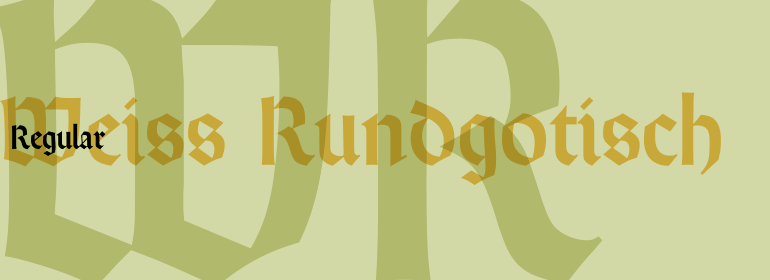字体说明
Weiss® Rundgotisch
字体英文名称:WeissRundgotischCom.TTF

Weiss® Rundgotisch
品牌:Linotype(Monotype)
设计师:
Wei?,Emil Rudolf
发行时间:2018
字库编码:
Unicode
分类:
字体属性:
字体介绍
1937年,德国设计师Emil Rudolf Weiss为 Bauer 字体铸造厂设计了Weiss Rundgotisch。在他们的字体目录中,Bauer一开始引用了Leonhard Wagner的话:圆圆的哥特式(rundgotisch)字体是最美丽的字体;她被称为母亲和女王。在设计Weiss Rundgotisch时,Weiss受到了Augsberg印刷商Erhard Ratdolt的文艺复兴时期字体风格的启发。Ratdolt曾在威尼斯呆过一段时间,他很可能就是在那里熟悉了圆圆的哥特式字母。这种字体在德国从来没有像德文Fraktur 或者Gotisch那样流行,但圆型哥特式字体在那里使用了几个世纪,代表了艺术和工艺的感觉,以及老式的手工。<br><br>
对于黑体字,Weiss Rundgotisch与普通的衬线字体和无衬线字体设计非常相似,尤其是它的大写字母,似乎也有一些特殊的影响。因此,对于当代读者来说,Weiss Rundgotisch更易于阅读,对于任何想要设置文本、标识或标题的人来说,这是一个非常好的选择。<br><br>
Weiss Rundgotisch显然是一个很难设计的字体,即使对于像Weiss这样的大师来说也是如此。他从1915年开始研究; Weiss Rundgotisch的研发花了20多年才完成。”<br><br>
The German designer Emil Rudolf Weiss originally created Weiss Rundgotisch for the Bauer typefoundry in 1937. In their catalog for the typeface, Bauer began with this quote from Leonhard Wagner: The round gothic (rundgotisch) script is the most beautiful kind of script; she is called the mother and the queen of all the rest."
<br><br>
While designing Weiss Rundgotisch, Weiss was inspired by Renaissance types cut by the Augsberg printer Erhard Ratdolt. Ratdolt had spent some time in Venice, which is most likely where he became familiar with round gothic letters. This sort of letterform was never as popular in Germany as Fraktur or Gotisch may have been, but round gothic types were used there for centuries to represent arts and craft feelings, as well as old-fashioned handwork. <br><br>
For a blackletter typeface, Weiss Rundgotisch is very similar to normal serif and sans serif designs, especially its uppercase letters, which seem to have some uncial influence in them as well. Therefore, Weiss Rundgotisch is more legible for contemporary readers, making this an excellent choice for anyone looking to set text, logos, or headlines with in blackletter.
<br><br>
Weiss Rundgotisch was apparently quite a difficult typeface to design, even for a master designer like Weiss. He began work on the face in 1915; Weiss Rundgotisch’s development took over 20 years to complete."
